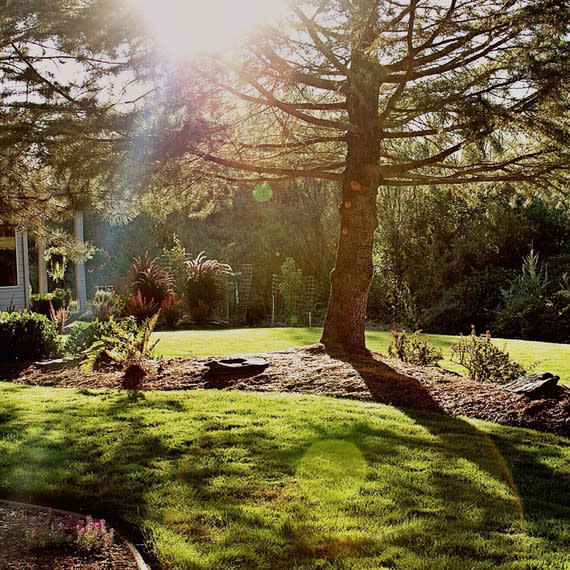How to Landscape Your Backyard

It may seem like you're just a few trips to the garden center away from a whole new yard—after all, home improvement shows make outdoor makeovers look as simple as adding some new plants and fluffing up some all-weather pillows. In reality, designing an outdoor space can be as complicated as designing an indoor one—or more, depending on how much you're trying to change. There are a few steps you can take to get started, but many people benefit from at least consulting with a professional, as there's a huge amount to know about natural conditions.
In fact, the National Association of Landscape Professionals recommends finding someone with either a secondary degree in the field or several years of experience, and with membership to various local or national industry associations to keep them up-to-date on trends, best practices, and safety. Just like you would before hiring any other professional, it helps to educate yourself on the basics first. Here's what you need to know about landscaping your backyard.
Related: Beautiful Landscaping Ideas to Wow Guests at Your Next Outdoor Gathering
Understand the Components
What actually constitutes a well-designed garden? Well, that's specific to the owner. Start by thinking about how you intend to use the space and what you imagine happening in your garden throughout the year. "The garden can serve many purposes and should be designed for that," says Rebecca Bullene, founder of Greenery NYC, a botanical design company based in Brooklyn. "There should be an area for eating alfresco, and/or cooking with a grill, a place for quiet contemplation or reading, and a place for gathering and entertaining. I really try to get to the uses a client wants to have, and let that inform the design."
Find Your Style
Whiling away hours on Pinterest and Houzz may not seem like important work, but it's a key step in identifying your gardening style. "People should envision the space they want to relax and entertain in," says Bullene. "Ultimately we want outdoor spaces to be usable, and they should be designed with that in mind." Think in terms of design elements rather than entire gardens to help narrow down what will make you happiest —maybe it's a sleek ipe wood fence, a bright peony border, or a hammock tucked beneath trees.
It's also okay if your dream garden isn't an exact echo of your dream house; the right professional will help sort out how to make a love of boho vines and wildflowers blend with a more traditional home. "There's nothing harder than starting a project with someone who really doesn't know what they want, so take the time to create inspiration boards as it sets the tone and direction," she says.
Assess Your Space
Before you officially hire your landscaper, Bullene recommends reading their online reviews and looking at examples of their past work. You should also schedule a face-to-face meeting to make sure you'll work well together. During their visit, your landscaper will examine your site for few key factors, like the direction your garden faces, the amount of light your garden receives, and what the air flow and wind is like. If you're not working with a landscaper, make note of these details on your own. Once you have this information, it's time to check against your inspiration photos to see if your wish list is possible given both your space and budget: invisible expenses like irrigation, mulch, and removal of existing plants and debris can eat up a lot of money before you ever get to purchase a single plant.
Related: The Ultimate Guide to Keeping Mosquitoes Away
Know Your Limitations
There are certain things that just won't be possible in certain spaces, and your team should be honest with you about what you can and can't do in your yard. "In my experience, most people like to keep old trees, but occasionally we have to make room and take them out. If a client wants to have a veggie garden but the entire space is shaded by a tree, it won't be possible for them to successfully grow food," says Bullene.
There are also the realities of maintaining an outdoor space that should be considered within the design. "It's too much to ask someone to hand-water a roof garden twice a day in August, so with automated irrigation, no one has to worry things will get too dry," says Bullene. In a more suburban or rural setting, deer and squirrels are constant enemies, so fencing and motion-activated sprinklers can be added to get them to stop frequenting a garden, or you may want to extend electrical onto your terrace to plug in a fan to keep bugs at bay.
Plan for Plants Year-Round
Even if you intend to use your outdoor space primarily during the warm months, your design should add visual value to your home all year round, as it's a big investment. "I think evergreens are an important component of any garden to give it year-round appeal," says Bullene. "I consider those the bones of the garden and start there, then incorporate deciduous trees and shrubs, perennial plants, and finally annuals for pops of color."
When planning a garden, make sure to think of the succession of color and blooms, and research which types of plants bloom when before you start planting anything. "This type of successional planning means there's something of interest in every season. In spring, I may have pink and purple blooms of crocus, tulips and other blooms, and in summer the colors move more into reds and oranges and yellows from roses and lilies, and then autumn, I let the deciduous plants really shine," she says. "In good garden design, always think about the progression of color in a space."
